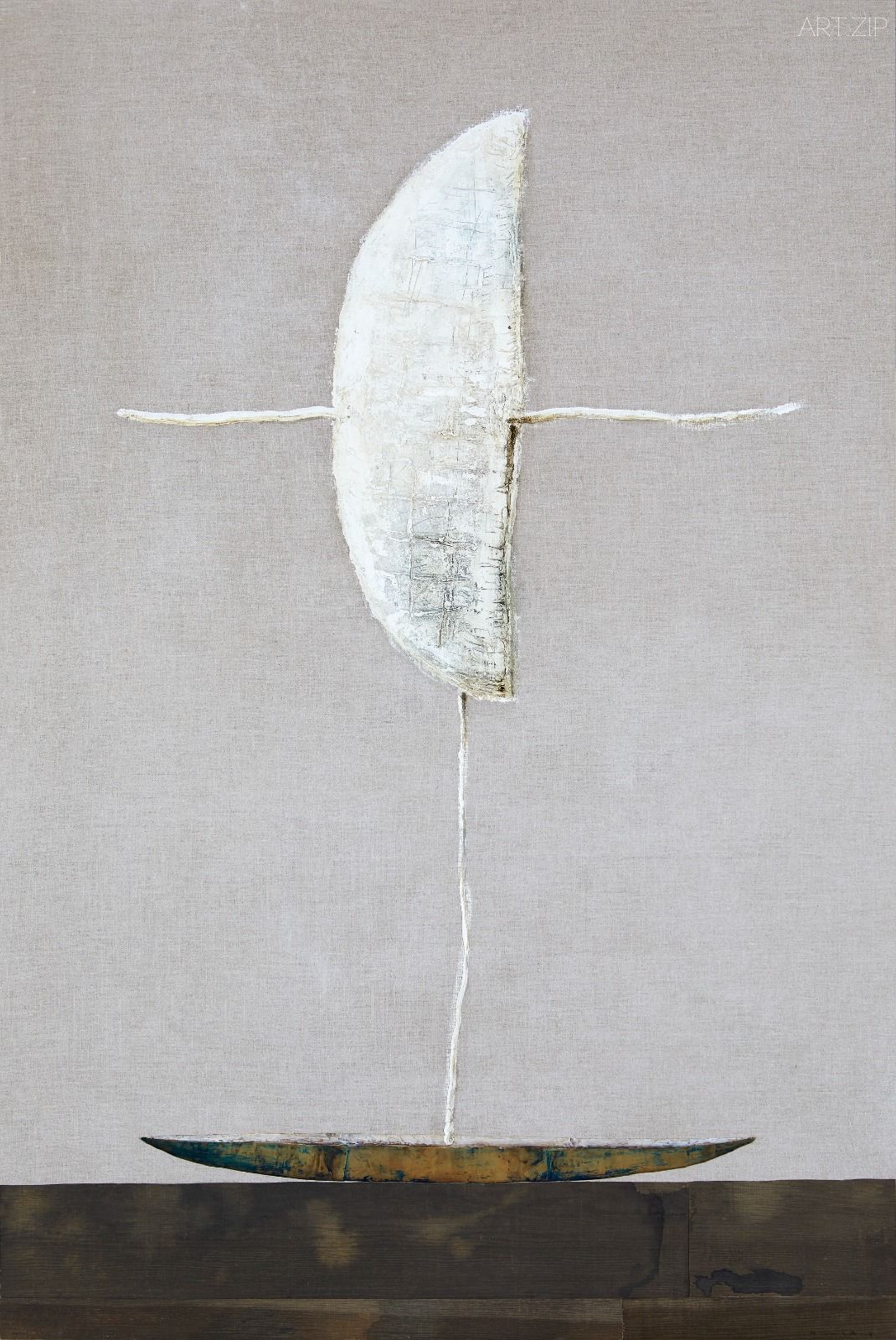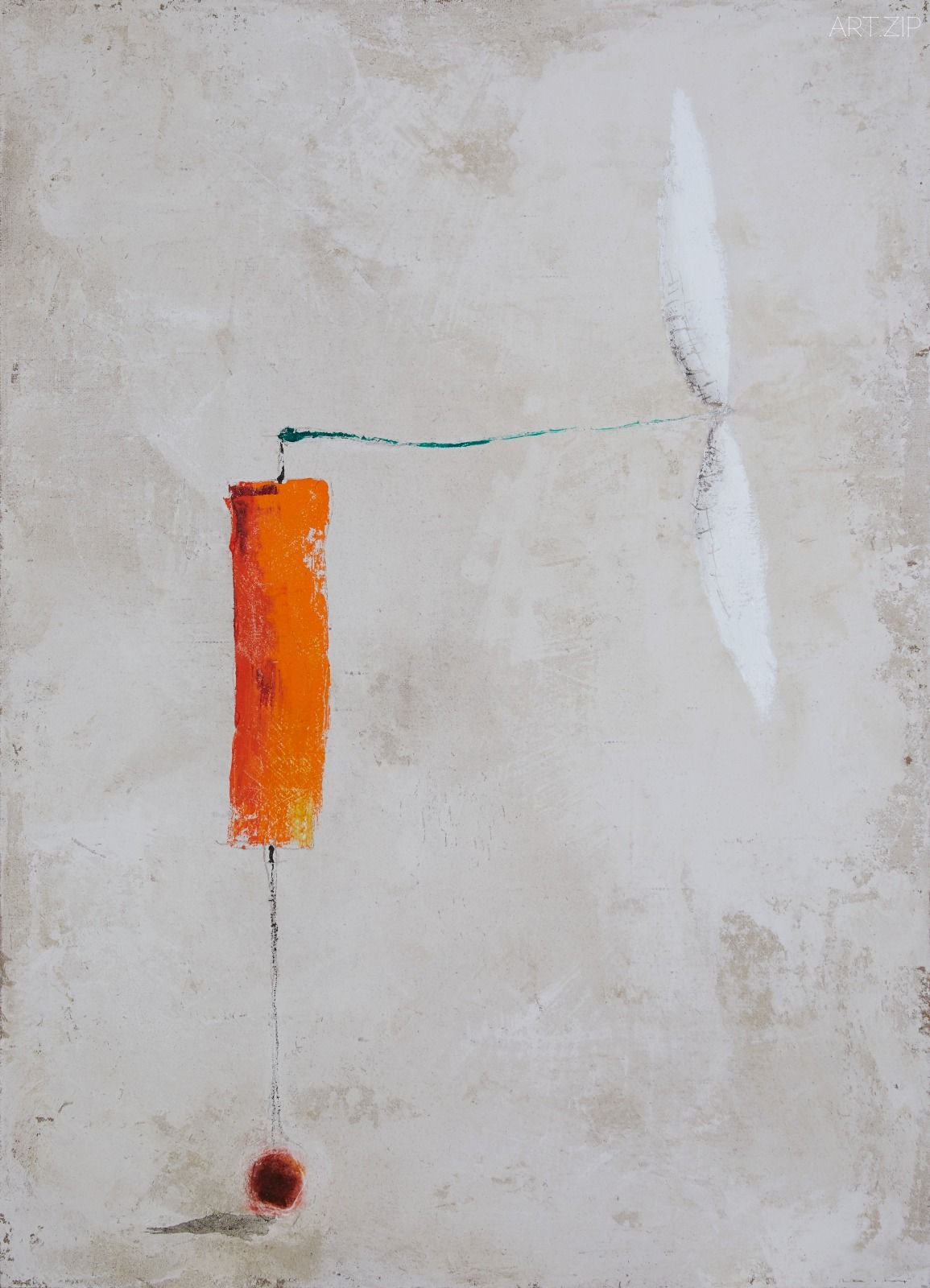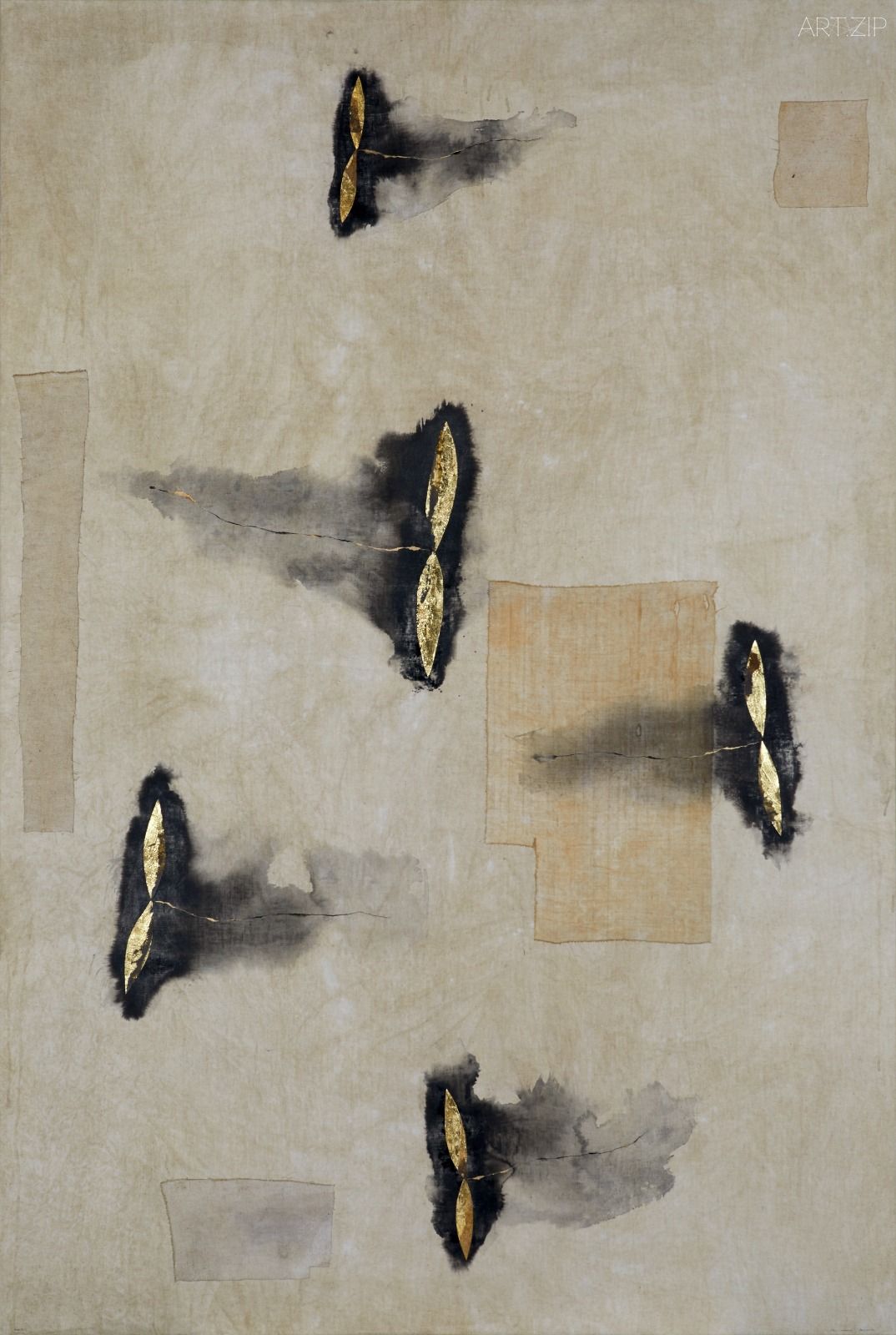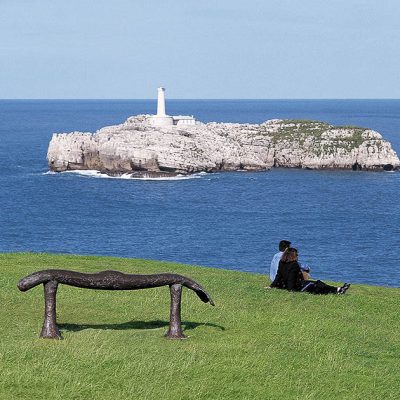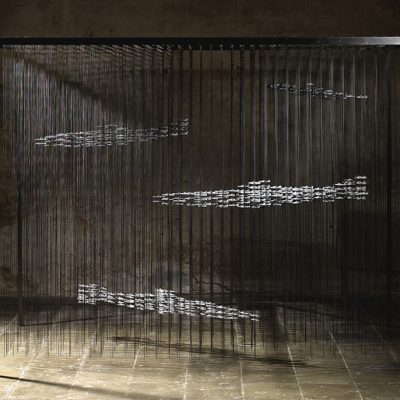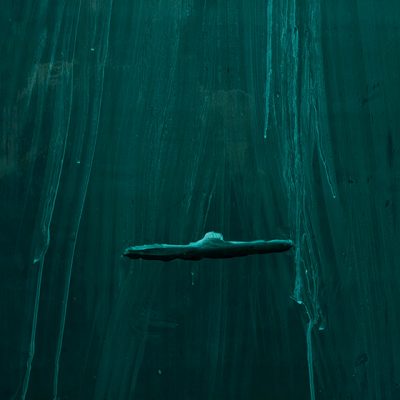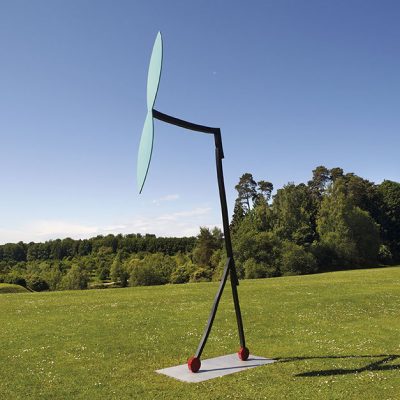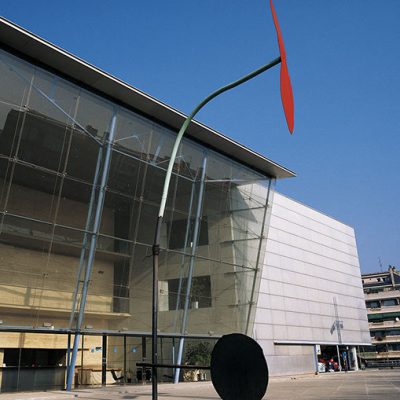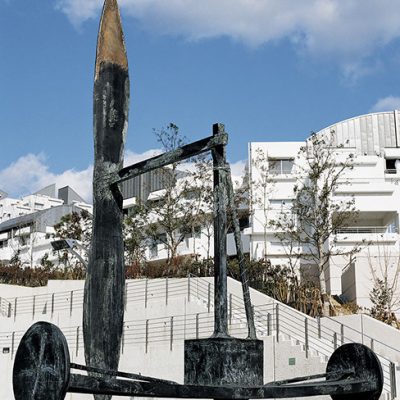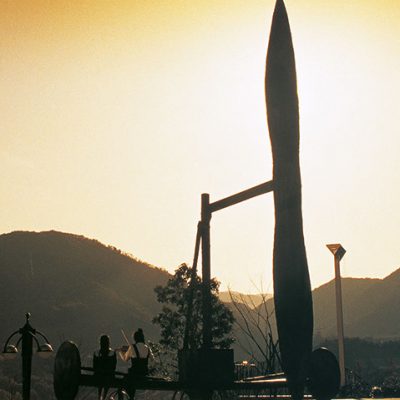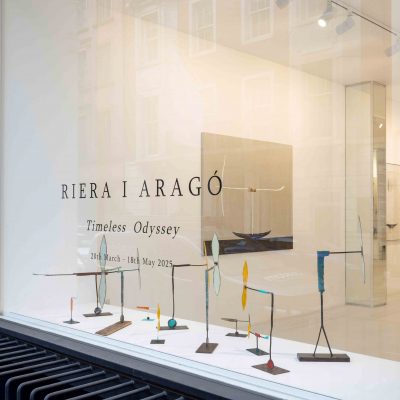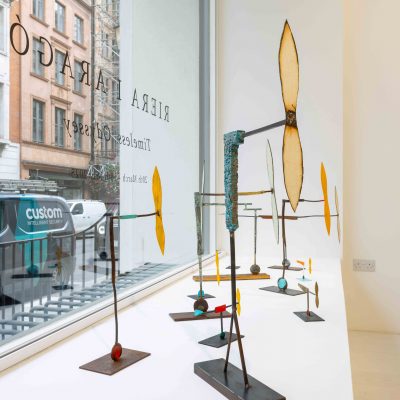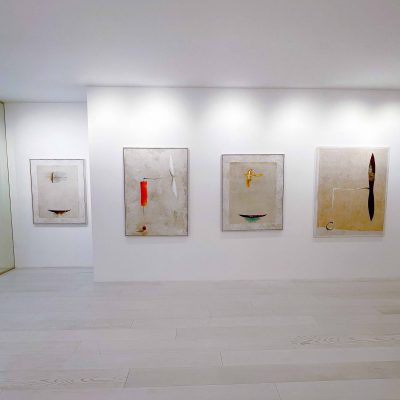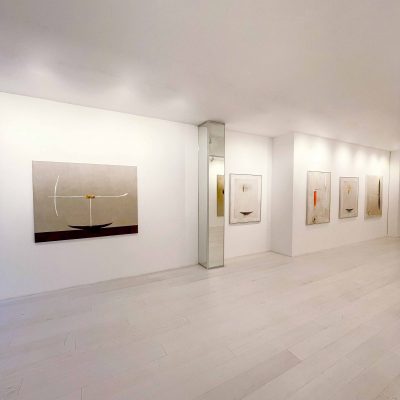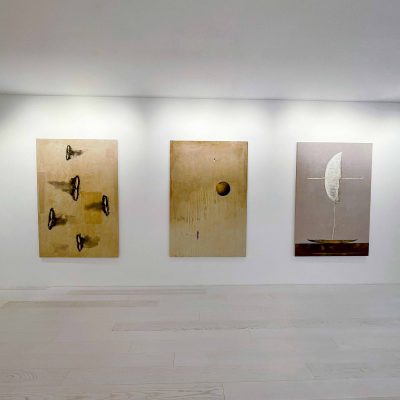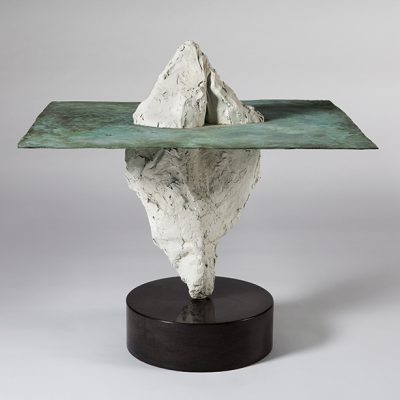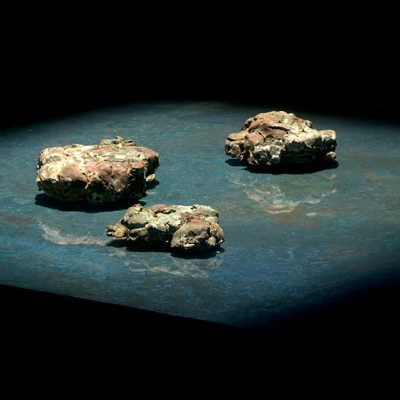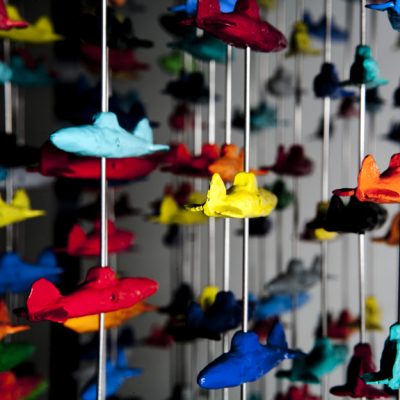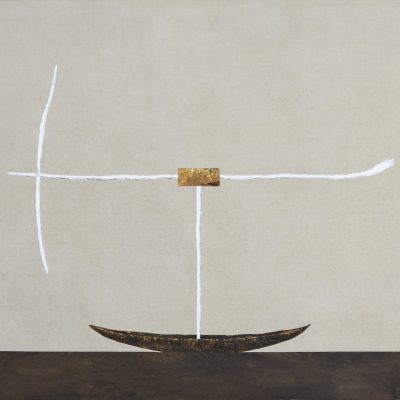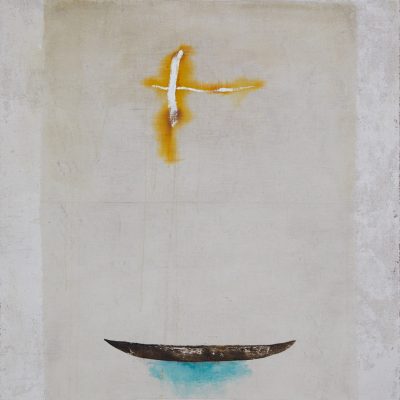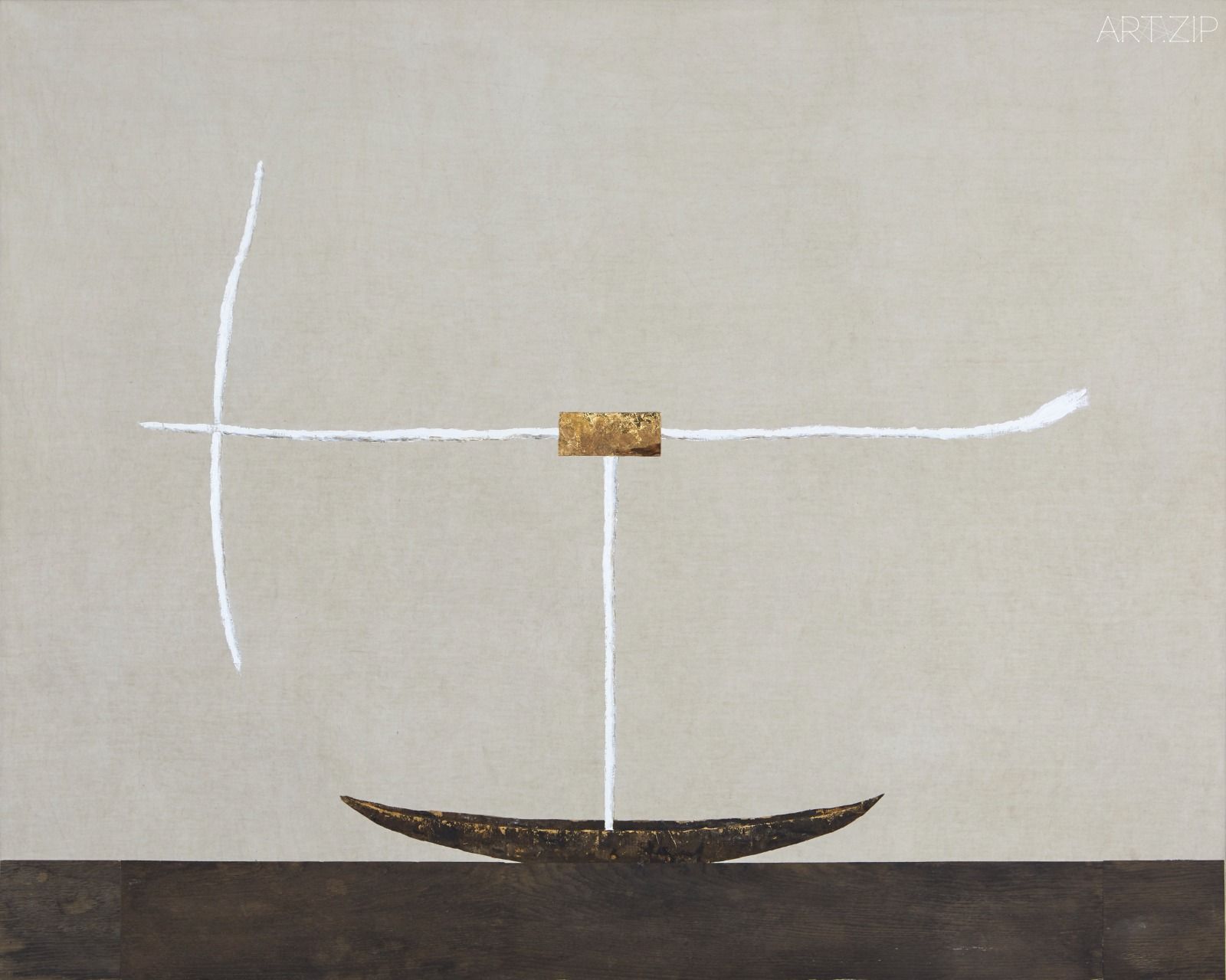
Bluerider ART
Mayfair London
20th March – 18th May 2025
Like a messenger from a dream, the machine drifts lightly through the folds of time and space—at once familiar and strange—radiating a quiet, mysterious beauty. Barcelona-based artist Riera i Aragó employs seemingly ordinary symbols—airplanes, propellers, submarines, and boats—to evoke humanity’s enduring desire to explore. His creations form a delicate tapestry of memory and dream, inviting viewers to revisit their own recollections, aspirations, and the subtle traces left by time.
In Aragó’s works, A White Wing Plane on Boat hovers across the canvas like a sail lit by a crescent moon—gentle and distant, as if suspended in a dreamlike stillness. An Orange Body Airplane transforms into a refined, abstract mechanical being, gliding freely through an infinite cosmos, seeking dimensions yet to be named. And in Five Golden Airplanes on Black Stains, golden propellers drift through a hazy, surreal landscape, like stray shooting stars—fragments of fleeting memories quietly emerging from the depths of an inner voyage.
There is, for some viewers, a haunting and fragile beauty in Aragó’s works—a quiet poetry that stirs the imagination. Constructed from discarded mechanical fragments, they do not mourn the past; instead, they carry it forward, opening softly into possibility. Aragó reduces visual language to its most essential lines and gestures, yet each work resonates with metaphor—echoing the many journeys we take, across land, through memory, and into the invisible landscape of the soul. His art becomes an invitation to pause, to reflect—a dialogue spoken not in words, but in presence.
In March 2025, Bluerider ART presented Aragó’s first solo exhibition in the UK, Timeless Odyssey, at its London Mayfair gallery. We had the privilege of speaking with the artist and joining him on this poetic voyage—one built from machinery and dreams.
AZ: Your sculptures often transform machines into poetic symbols. How do you see these discarded or non-functional machines as representation of the passage of time and life’s journey?
RIA: These machines are the ones I chose to make my journey. They appeared because I was-and still am-interested in exploring fascinating and unknown worlds, such as the ocean floor and the cosmos. Submarines and airplanes have allowed me to imagine this journey. I think this comes close to the kind of poetry that emerges through the act of creation.
AZ: You frequently use airplanes and submarines in your work, giving them human-like qualities. Does this reflect how you view the relationship between technology and humanity?
RIA: I’m not interested in technological aspects. It’s not my field. I’d be more interested in philosophical or vital aspects. My works are more near the human aspect rather than the technological aspect.
AZ: You often work with recycled industrial materials. How do you view the concept of “time” in your sculptures? Do these weathered, aged remnants symbolize memory, decay, or rebirth?
RIA: It’s true, materials often carry the memories of their past, and it’s the memory that interests me. I try to rescue it, to give it a new life through my works. I’ve been deeply interested in the theme of the passage of time. Submarines, for example, perhaps best embody this idea–something very old and degrading at the bottom of the sea.
There was a time when a shipwreck occurred in the harbour of Barcelona. I used to go there – apart from the fact that it was epic how they were cutting it up – to buy scrap metal from scrapped ships. The metal bore traces of its history: layers of peeling paint, corrosion from years at sea. I used many of those pieces—fragments of iron marked by time—into my sculptures. For me, it’s about memory, and also about rebirth.
AZ: You’ve mentioned that your artistic language began with a daily drawing exercise in 1982. How did that practice influence your creative vocabulary and artistic direction?
RIA: It was from March 1982 to March 1983. For 365 days, every night before going to bed, I made a drawing of something that had happened to me that day. I had to express everything I wanted to say through symbols. Over time, all the shapes emerged from these symbols have evolved, but their meanings gradually transformed. For example, in the beginning, the human figure was represented in the shape of an eye; this shape would later become the submarine or the zeppelin, and if we put it vertically and folded it, it became a propeller. Every day, I had to invent new symbols, and the ones I repeated evolved. This exercise helped me lay the foundation for what my work would become. I don’t use words, I just let symbols naturally come.

365 days. Courtesy of Bluerider ART
AZ: Your sculptures and paintings often coexist, exploring the same themes through different mediums. Do you approach the two practices differently, or do they inform one another equally?
RIA: Yes, they’re like my two hands, my right and my left. And it’s true that they complement each other and sometimes even create unexpected connections. I need both to fully express myself, although I’d said that since I’m right-handed, sculpture is my right hand.
AZ: Your recent works display a more minimalist form. What inspired this shift toward simplicity and purity in form?
RIA: I try to simplify as much as possible and stick to the essentials. If I can say something in one sentence, I don’t use two. This approach, admittedly, comes quite close to minimalism.
AZ: Timeless Odyssey is your first solo exhibition in the UK. Could you tell us more about the themes and inspirations behind this show? How does this show differ from your previous exhibitions?
RIA: Each exhibition shares something with the previous ones, and at the same time, brings something new. In this case, the gallery selected the works, choosing to highlight more painting than sculpture. That choice reflects one of the many ways my work can be approached. It’s open to different interpretations, depending on the perspective through which it’s viewed..
AZ: Your work seems to reference both modern science and a mythical, ritualistic dimension. How do you balance technological references with more spiritual themes?
RIA: It’s true that I am interested in science, or rather, in the progress of humanity, insofar as it represents an advance in our evolution, but the roots of human nature remain the same. What drives man to create art has not changed over time. I do not believe that we are far from cave paintings, and I would dare to say that in many cases we are still quite far behind.
AZ: Your art has been influenced by Joan Miró and Paul Klee. How have their abstract languages shaped your creative vision?
RIA: In the early 1980s, through the work of Joan Miró and Paul Klee, I realised that I didn’t have to look outward, but inward, to find my own path. I’ve often said that these two artists, who were about the same age as my grandparents, were like my crutches at the time, allowing me to begin forging my own path.
AZ: Your public art installations are displayed around the world. How do different locations influence the design and meaning of your sculptures?
RIA: Public sculpture plays a very special role within its environment, and we must be aware of this. It can’t be a UFO that appears out of nowhere. Whether it’s an urban setting or a natural one, many factors must be considered. The dimensions or scale of the work are very important. A piece must be just the right size to function, along with many other factors. When I got an offer to make a public installation for Nishinomiya, Japan, I visited Japan several times, and I was especially inspired by the shape of a seated Buddha, the shape of a triangle. That inspiration led to the creation of Najio Airplane.
AZ: Your recent works seem to reflect more on nature and ecology. Do you see yourself addressing environmental issues more directly in future projects?
RIA: Indeed, that’s true. In the early 2000s, I discovered what’s happening to the Aral Sea, which is drying up because the Aral River had been diverted to irrigate cotton fields. This ecological assault, which caused a major natural disaster and human tragedy, has moved me, and from that came the Aral figures–melancholic-looking artefacts that wander through space, watching the sea recede. This work was created in 2001. It represents a father and a son who were wandering together, looking for the vanished sea. It’s quite sad. This theme continues throughout many of my sculptures that related to water, which I often interpret as something almost sacred and a scarce good.
AZ: If you could collaborate with an artist or scientist -past or present-who would it be, and what kind of project would you create together?
RIA: I had one already. Several years ago, I had the opportunity to collaborate on a piece with Joan Oró, a Catalan scientist whose studies were fundamental to our understanding of the origins of life. He was also involved in several NASA projects, such as the Apollo and Viking programs. We created a joint piece in my studio, one of those works involving planetary forms, which was later auctioned for charity. It was a great experience.
AZ: If your airplanes or submarines could take you to any fictional world, where would you go, and why?
RIA: I won’t set a fixed direction. I’d prefer to explore freely and live that experience fully.
AZ: If your sculpture could speak, what do you think they would most often say to the viewers?
RIA: I’d prefer they remain silent, the world is already too noisy (laughs). I believe that silence is a great value, which allows other senses to come alive.
AZ: Have you ever given names or personalities to the flying machines and submarines you create? Which piece do you think has the most interesting “personality”?
RIA: I’ve never given them names. They’re submarines, airplanes…I’ve only named the Aral Sculptures, for the reference I mentioned earlier. Sometimes names come out unintentionally. In the 1980s, a friend of mine named a series of my very thin and fragile sculptures–made of iron and plaster–Mosquito Airplane, and that’s how they’ve been called ever since.
AZ: If one of your sculptures suddenly came to life and started flying or sailing, what kind of adventurous journey would you hope it embarks on?
RIA: They already have a life, their own life, and their journey is precisely the one they are making as they around the world, showing themselves to anyone who wishes to see them.
AZ: Your studio is filled with various mechanical parts–do you have a particular small piece that you consider your lucky charm or a source of inspiration?
RIA: No, I don’t. What matters to me is the energy that exists in the studio, and this is achieved by the amount of material I have accumulated and the perseverance in my daily work.
AZ: Has a viewer ever shared an amusing or unexpected interpretation of your work? How did you respond?
RIA: Yes, many times. I believe that the more interpretations a work can inspire, the better. Everyone is free to see what they want or interpret it however they want. I think they’re all fine as long as it comes from genuine interest and respect.
A visitor once cried after viewing my works in my studio. That moment deeply moved me. I realized that my art could truly touch people’s hearts and evoke an emotional resonance, which is incredibly meaningful to me.
In this conversation, Aragó reveals a rare blend of sensitivity and humility. His works unfold with quiet persistence, like verses gliding just above the surface—brushing against the edges of memory and perception. He reminds us that the role of art is not to deliver answers, but to create space: for seeing, imagining, feeling, and listening to silence.
As he reflects, “I prefer my works to remain silent, the world is already too noisy.”
Perhaps it is this stillness that gives his sculptures and paintings their quiet force—-awakening quiet, inner landscapes not yet named.
永恆的奧德賽——專訪里埃拉·伊·阿拉貢
宛如夢中的使者,機械以輕盈的姿態穿梭於時空的縫隙之間,既熟悉又陌生,靜靜地散發著一種神秘而安靜的美感。來自巴塞隆納的藝術家里埃拉·伊·阿拉貢(Riera i Aragó)用飛機、螺旋槳、潛艇和船隻等這些看似平凡的符號,刻畫著人類無盡的探索與旅程。他的創作如夢境與記憶的交織,邀請觀眾回望自身的記憶、夢想,以及時間流逝留下的微痕。
在阿拉貢的作品中,《白翼飛機與船》彷彿一葉風帆,在新月的光影下緩緩懸浮於畫布之上,輕柔遙遠,仿佛停駐在夢境的邊緣;《橙身飛機》則化身為一架纖細而抽象的機械生物,自由滑翔於無垠宇宙,探索那些尚未命名的維度;而在《五架金色飛機與黑色煙跡》中,金色的螺旋槳緩緩飄移於迷離的景象之中,如同幾顆流離的流星——是記憶深處悄然浮現的片段,在內心的航行中閃爍不定。
對某些觀眾而言,阿拉貢的作品帶有一種纖細而幽微的美,彷彿靜靜訴說著某種無聲的詩。這些由報廢機械零件構成的作品,不是為了哀悼過去,而是將過去溫柔地帶入未來的可能。他將視覺語言簡化為最本質的線條與形構,卻在每一件作品中注入深厚的隱喻——回應著人類在土地、情感、記憶與心靈中不斷展開的旅程。這些作品不是用語言訴說,而是以「在場」的方式,邀請我們靜靜凝視、停留、思索。
2025年3月,Bluerider ART倫敦梅費爾空間舉辦了阿拉貢在英國的首次個展《永恆的奧德賽》,我們有幸採訪了這位藝術家,隨他一同走進那場由機械、記憶與夢境構築而成的詩意航行。
AZ: 在您的創作中,機械常被轉化為帶有詩意的符號。您如何理解這些失去原來功能的機器?
RIA: 這些機械是我用來展開旅程的工具。它們之所以出現在作品裡,是因為我一直對那些未知而迷人的世界感到著迷——像是深海,或是宇宙。潛艇和飛機讓我得以想像自己進入那些領域,展開探索。我覺得,那種詩意,其實就是在創作的過程中自然浮現出來的。
AZ: 您經常在作品中使用飛機和潛艇,並賦予它們人性化的特質。這是否也反映了您對科技與人類關係的看法?
RIA: 其實我對科技本身並沒有特別感興趣,那並不是我關注的領域。我感興趣的是哲學層面,或者與生命相關的內在經驗。我的作品與其說是在呈現機械,不如說是在探尋它們背後的情感與哲思。
AZ: 您經常使用回收的工業材料,而這些材料本身就帶有時間的痕跡。在您的雕塑中,您如何看待「時間」的概念?這些風化的物件對您來說更像是記憶的承載體還是全新敘事的起點?
RIA: 的確,材料本身往往承載著它們過去的記憶,而正是這些記憶吸引了我。我試圖將它們從被遺忘中「喚回」,並在作品中重新賦予它們生命和意義。時間流逝的主題一直讓我十分著迷。潛艇或許最能體現這種意象——深潛在海底,隨著歲月慢慢老化、腐蝕,彷彿時間在它的表面沉積。
在巴塞隆納港口曾經發生過一起船難,我經常去那裡,被拆解船隻的場景所深深吸引。那一幕充滿了史詩般的震撼。我會從報廢的船上購買廢舊金屬,那些金屬上殘留著已經剝落不少的油漆,還有覆蓋著海水侵蝕的斑駁痕跡。我將這些帶著歲月印記的鐵片融入雕塑之中,讓它們承載過往,也象徵重生。
AZ: 您曾提到,您的藝術語言始於1981年展開的每日繪畫練習。這段經歷對您的創作語彙與方向產生了什麼影響?
RIA: 其實那段練習是在1982年3月到1983年3月之間進行的。當時,我連續365天,每天睡前都會畫下當天發生的事。我必須用最簡約的圖像符號來表達所有想說的內容。這些符號漸漸演化,成為我創作語言的基礎,而且它們的含義也隨著時間不斷發生了變化。
比如在最初的符號中,「眼睛」代表人的存在,後來隨著時間推進,這個形狀轉化成潛艇,或齊柏林飛船的輪廓。而當這個形狀垂直擺放並加以折疊,它又成為了螺旋槳。每天,我都在發明新的語彙,而那些我不斷重複使用的符號,也在日復一日的書寫中持續演化。這段練習幫助我奠定了日後創作語言的基礎。在這段練習裡我完全不使用文字,只有圖像與符號,自然而然地發展出一套屬於自己的語彙系統。
AZ: 您的雕塑與繪畫經常在展覽中並置,通過不同的媒介來探索相同的主題。在創作這兩種形式時,您會採取不同的方法嗎?或者它們之間其實相互補充?
RIA: 是的,對我來說,雕塑與繪畫就像我的雙手——一左一右,缺一不可。它們彼此補充,有時還會在創作中彼此對話、產生連結。我需要這兩種形式來完成我的表達,儘管我說過雕塑更像是我的「右手」,而我是「右撇子」。
AZ:您的近期作品展現出更簡約的造型語言,是什麼啟發您向這種純粹與簡潔的風格發展?
RIA:我嘗試將表達簡化到最純粹的狀態,只保留那些真正必要的元素。就像語言一樣,如果能用一句話就足以表達,我便就不會用兩句。這種做法,也許某種程度上的確接近於極簡主義,但對我來說,更像是一種向本質靠近的練習。
AZ:《永恆的奧德賽》是您在英國的首場個展。您能與我們分享這次展覽背後的主題與靈感嗎?這次展覽與您過去的展出有什麼不同之處?
RIA: 每一場展覽其實都與過去的展覽有所關聯,但同時也引入新的元素和視角。這次在倫敦的個展,畫廊更側重於選擇繪畫作品的呈現,而不是以雕塑為主。這也恰好展現了我的創作特質——它們總是能從不同的角度被觀看、被理解。每次展出,就像一次新的編排與對話,讓作品在不同空間中產生新的語境。
AZ: 您的作品似乎同時參照了現代科學與神話般的儀式感。在創作過程中,您是如何在科技的參照與精神性的探索之間取得平衡?
RIA: 的確,我對科學抱持著興趣,但更準確地說,我更關注人類在演化中的進程——因為那象徵著我們不斷前行、嘗試超越自身的能力。然而,儘管科技日新月異,人性的本質始終未變。那種推動人類創造藝術的內在驅力從未消失。我並不認為我們與史前洞穴壁畫的創作者又多麼遙遠。甚至我敢說,在許多情況下,我甚至覺得我們還遠遠落後於他們。
AZ: 您的藝術深受米羅與克利的影響。他們的抽象語言是如何影響您的創作視野的?
RIA: 在1980年代初期,我透過米羅與克利的作品逐漸意識到,藝術的源頭並不來自外部世界,而是在我們內心深處。正是他們讓我懂得開始向內觀看與探索,在自我中尋找創作的起點與方向。我經常說,這兩位年紀與我的祖父母相仿的藝術家曾是我創作初期的「拐杖」,他們的作品與精神陪伴著我邁出自己的步伐,找到屬於自己的獨特的藝術語言。
AZ: 您的公共藝術裝置遍布世界各地。不同的地點是怎麼影響雕塑的創作與意涵?
RIA: 公共雕塑在它所處的環境中扮演著特殊的角色,因此我非常重視作品與場域之間的關聯;它不能像突如其來的不明飛行物UFO一般,毫無脈絡地降落在某個地方。無論是在城市空間還是自然環境中,許多因素都必須被考量。作品的尺寸或比例尤為重要,它們必須恰到好處,才能真正與環境對話,並達成一種和諧的共存。
當我受邀為日本西宮市創作一件公共藝術裝置時,我曾多次前往當地考察。那次,我受到佛像造型的啟發,特別是坐姿佛像中所呈現出的三角形結構,讓我深受觸動,於是我創作了《Najio Airplane》。
AZ: 您近期的作品似乎越來越關注自然與生態主題。您是否計劃在未來更直接地探討環境議題,例如氣候變遷?
RIA: 是的,的確如此。早在2000年代初期,我了解到了鹹海(Aral Sea)正在乾涸的情況。人類為了擴大棉花種植而將河流改道,導致這片湖泊逐漸消失。這場生態浩劫不僅引發了自然災難,也帶來了人道悲劇。這深深地觸動了我,並啟發了《Aral Figures》系列的誕生。在這些作品中,飛行器被賦予了一種近乎人性的情感——它們神情憂傷,彷彿在無垠的空間中徘徊,注視著逐漸消逝的大海。這件作品創作於2001年,象徵著一對父子在海邊尋找消失的海洋,作品本身瀰漫著難以言說的悲傷與無奈。這樣的主題也延續到許多與「水」有關的雕塑作品中。在我心中,水是一種神聖且稀有的存在。
AZ: 如果您能與一位藝術家或科學家合作——無論是過去或當代——您會選擇誰?您希望與他們共同創作什麼樣的項目?
RIA: 幾年前,我曾有機會與加泰隆尼亞科學家胡安·奧羅(Joan Oró)合作。他在生命起源方面的研究具有深遠影響,並參與過多項 NASA 計劃,包括阿波羅與維京任務。我們在我的工作室共同創作了一件作品,這件作品最終被用於慈善拍賣。那次合作經歷對我來說非常難忘,也讓我感受倒科學與藝術之間的共鳴。
AZ: 如果您的飛機或潛艇能帶您前往任何一個虛構世界,您會選擇去哪裡?為什麼?
RIA: 我不會預設目的地。我更希望能夠無拘無束地探索,並全心全意地體驗這段旅程本身。對我來說,旅程永遠比抵達更重要。
AZ: 如果您的雕塑能說話,您覺得它們最常對觀眾說的是什麼?
RIA: 我寧願它們保持沉默(笑),這個世界已經太喧囂了。我相信沉默是一種珍貴的價值,它讓其他感官有機會被喚醒。
AZ: 您曾經為飛行器或潛艇雕塑命名或賦予它們個性嗎?您認為哪件作品最具「個性」?
RIA: 我從未刻意給它們命名,它們就是潛艇或飛機……不過,唯一被命名的系列是《Aral Figures》,跟我提到的鹹海事件有關。有時候名字會在不經意間出現。1980年代,有位朋友為我一系列用鐵與石膏製成的纖細雕塑取了個名字:《蚊子飛機(Mosquito Airplane)》,這個名字一直沿用至今。
AZ: 如果您的雕塑突然擁有生命,開始飛行或航行,您希望它們踏上什麼樣的冒險旅程?
RIA: 其實它們早已有了自己的生命,而它們正在進行的旅程便是它們在世界各地被展出的過程,它們遇見了來自不同文化、背景、情感狀態的人,讓任何願意欣賞的人與它們相遇。
AZ: 您的工作室裡擺滿了各種機械零件和材料。您是否有特別珍視的小物件,將它視為幸運符或靈感來源?
RIA: 沒有。我更在意的是工作室本身所蘊含的能量,而這正是那些日積月累收集的材料、還有日復一日的創作過程所凝聚出來的氣場。
AZ: 觀眾是否曾向您分享過對您的作品有趣或出乎意料的詮釋?您如何看待這些來自外部的閱讀?
RIA: 是的,很多次。我認為一件作品能夠引發多種詮釋是件好事。每個人都可以依照自己的感受去解讀,我覺得所有的詮釋都是合理的,只要是出於真誠與尊重。我記得有一位訪客曾在參觀我的工作室後流下眼淚,那一刻讓我深受觸動,因為我意識到作品能夠觸及人的內心,喚起情感上的共鳴,這對我來說是非常有意義的。
在這次訪談裡面,阿拉貢展現了他令人敬佩的敏銳與謙遜。他的作品不疾不徐,像低空飛行的詩句,輕輕掠過我們的記憶與感知邊界。他讓我們意識到,藝術的目的不在於給出答案,而是在於製造空間——讓觀看、聯想、情感與沉默得以並存。
正如他所說:「我寧願我的作品保持沉默,這個世界已經太喧囂了。」也許正是這份寧靜的力量,讓他的雕塑與繪畫,在無聲中喚醒了我們內在尚未命名的風景。
Text and Interview 撰寫及採訪 x Rinka Fan
Edited 編輯 x Michelle Yu

